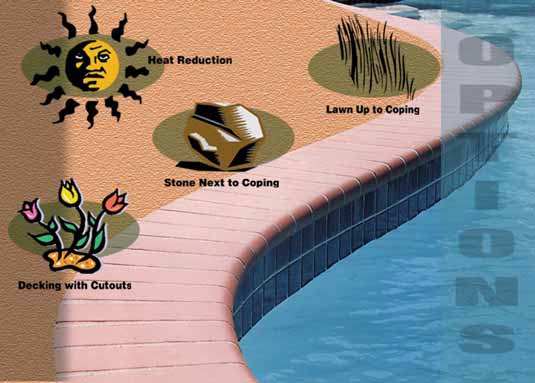Landscape, Plants, Hardscape & Decks
I feel like I'm working backward: First, I told you about a gargantuan water lily and its very specific requirements, then I offered a more general look at water lilies that will thrive in almost any pond. Now I'm going to give you some ideas and tips for designing with all types of water plants. It might have been more logical to approach things the other way around, but the important thing is that we're ready to complete the package and talk about ways of incorporating lilies and water plants of other sorts into beautiful, overall planting designs. As always, I will avoid getting too specific with recommendations. Instead, I'll stick to basic
So you read my last article and were so excited about Amazonian Water Lilies that you'd decided to talk some clients into going for it. But alas, after measuring their yard, you recognize that you won't have enough room to accommodate the gargantuan watershape you'll need to host such an immense plant. But your clients are still hot to trot with something unusual, even after you've accepted the fact that
Some may disagree with me, but I don't see faux rockwork as a "sculptor's art form." For more than 25 years, I've made sure that Mother Nature is the one who does the detail work; what I do is take copies of her artwork to job sites and install them in creative and interesting ways. A long time ago, I developed a method of making castings of real rocks using my own formulation of fiberglass and epoxy. These are exact replicas of the real thing: Once mounted on steel structures in swimming pools or other hardscape applications, the panels are
This past summer, I had the pleasure of traveling to Europe - specifically Northern Italy and Southern France. Along the way, I was lucky enough to see the lavender fields of Provence in peak bloom and many unusual and beautiful gardens. My travels were particularly rewarding in the region around Lake Maggiore in Northern Italy, well known for having some of Europe's most beautiful gardens. We started off by visiting the islands on the lake and their villas, complete with their classic-style gardens. The climate of the area allows for growing many of the plants I'm familiar with in Southern California, but the
Just as every garden should reflect the aesthetic values of its owners and accommodate their lifestyle preferences, so too every watershape should reflect the nature, purpose and "meaning" of the garden it inhabits. If it's a Victorian garden, then the watershape should be of similar style - perhaps a blend of formal and natural elements with stone or brick accents. If the theme is "wild, romantic tangle," then cascades, blossom-laden pools and rambling roses may be in order. For its part, a simple, paved court may call for a
As fall looms before us, it's timely to consider a question that should be a factor in every design we prepare: To drop or not to drop? This question is a good one to ask before you start planning and has to do with how much natural debris your clients will be willing to fish out of their watershapes once you're gone. In other words, while it's always important to decide what style of plants to put around your watershapes, it's also important to think about types - that is, evergreen vs. deciduous. I'm sure most (if not all) of you are aware of the general distinction, but here's a short
Is one person's trash really another person's treasure? That's a concept we tested on a recent Surprise Gardener episode, where we ran into a strange backyard "centerpiece" and, as the designer with final say, I had to decide whether to cover the thing up or make it stand out. The challenging objet d'art was an old truck chassis, abandoned and sunk into the yard many years before. Because of its location, it was something of a focal point. The homeowner had tried sticking an old whiskey barrel in the middle of the truck as a planter in hopes of
For some time now, watershapers have exploited the fact that naturally occurring rocks and boulders can enhance the appearance of their work. Whether used in conjunction with artificial rock or alone, you appreciate the fact that rock comes in a never-ending variety of shapes, sizes and textures - and that they can be used to add both surprise and individuality to designs. For the most part, however, designers and builders have tended to work with common local stones - fieldstone, granite or river rock - that limit their palettes when it comes to color, visual appeal and expressiveness. It can indeed be an epiphany for those who've used common stones to come across material that includes complex mineral and crystalline structures or fascinating patterns of stratification that are the product of eons of metamorphic activity within the earth's crust. With this awareness comes the realization that the palette is virtually limitless and that rockwork can now easily be found to echo the colors and exceptional nuances found in
A good friend of mine once told me that his idea of the perfect yard was one where he could walk around naked - and none of his neighbors would be able to see him. What a concept! Unfortunately, few of us can afford a yard so large that we could not be seen by neighbors under any circumstances. So what can you do to create that perfect private environment? As we'll see here, you have a lot of choices. DISCOVERING PREFERENCES Many people go all the way in creating privacy by building structures that make them feel safe and enclosed. Others prefer a less claustrophobic approach, such as soft plantings. Either way, and particularly when you are dealing with watershapes where your clients may want to enjoy communing with nature in the buff, creating some type of barrier against neighbors' intruding eyes is essential. Your clients' preferences may
Your clients are thrilled with your pool design - with one exception. It may be set up to withstand a 9.0 earthquake, but with all that decking and concrete, it resembles a bomb shelter. Apparently while you were working with the client's desire for seismic durability in mind, you lost sight of their additional desire for soft, rolling meadows. I exaggerate here to make a point: Too many watershapers are reluctant to






















